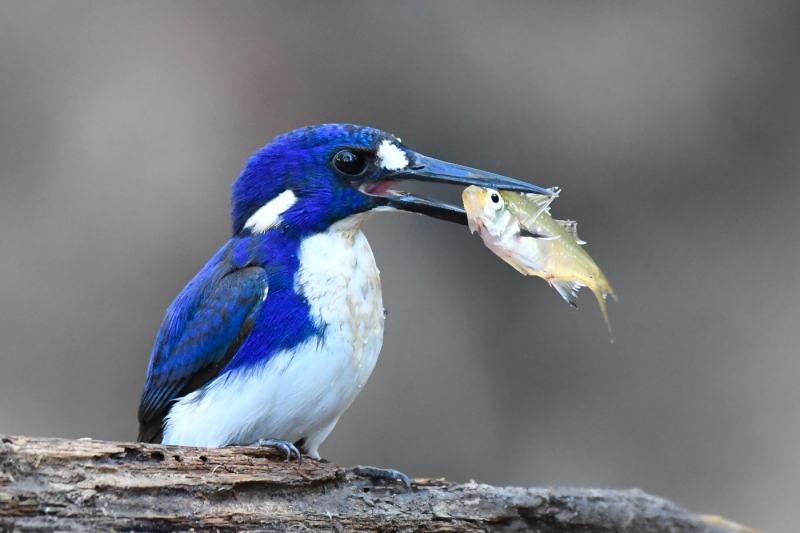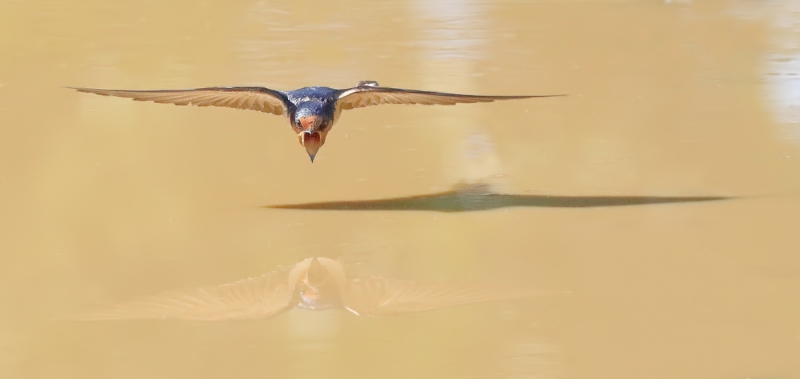The Small is Splendid competition was held through July and August 2018. The brief for this competition was to submit pictures of birds whose largest size, given in most field guides, is 20cm or less. Fifteen photographers submitted a total of 51 entries, each and every entry a high-quality image. With so many worthy images, selecting the top five images was once again a most difficult task and came down to the smallest of differences.
Australia is fortunate to possess so many glorious species in a range of sizes, shapes and colours. The species chosen by members for this competition depicted many of our small and splendid species. In judging each image, I was looking for any element in the image that distinguished it above all others.
Winner: Little Kingfisher, by Brian O’Leary (Image ID 31286)
A beautiful portrait of a Little Kingfisher with prey, and it is the prey item that distinguishes this image; it provides context for the bird in its habitat. The subtle grey tones in the branch and background work together to highlight the brilliant cobalt and white of the Kingfisher. The small fish in the bird’s bill is a delicate grey-green, which allows the fish to stand out from the background without overpowering the overall composition. Sharpness is a key element in any image; in this image the sharpness of the eyes in both the kingfisher and prey provide that essential connection between observer and subject matter. There is so much to like about this image. My only suggestion is to determine if reducing the highlights will pull back more details in the white feathers of the kingfisher.
Highly Commended: Welcome Swallow, by Con Boekel (Image ID 31384)
A sensational image that conveys both technique and the art of photography. The photographer has captured a technically superb low-angle image of a swallow in flight. In that same instance, reflections and shadows combine to produce a unique image. The viewer’s eyes are drawn initially to the bird, then the bird’s shadow and finally to the faint reflection of the bird in the muddy pool. These three elements may readily arise from an artist’s brush strokes on a canvas, rarely do they align so perfectly in action photography. There are other subtle reflections in the water from unseen background objects and these convey depth in the image. Whilst this image lacks an intense colour palette, it is the subtle nature of the tonal range of the yellows and browns that add a special quality to the image. Why is the bird’s bill open – is it feeding or is it calling? This is yet another element in this image that captures the imagination of the observer.
Commended: Scarlet Honeyeater, by Stephen Garth (Image ID 31262)
Another high-quality image of a bird utilising the habitat in which it resides; in this case, a honeyeater feeding on a callistemon flower. This image portraits a superb palette of colours which is enhanced by the tonal qualities of the reds. The yellows and greens in the background complement each other and at the same time provide an appropriate backdrop for the rich reds. The richness of the reds is in part due to the bird feeding in the shadow of the flower and although the main subject is in subdued light, the details in the feathers are well portrayed.
Commended: Striated Fieldwren, by Mark Lethlean (Image ID 31406)
The key element in this image is the engagement of the bird’s eye with those of the viewer. As the bird looks directly at the observer, it stands proud and alert. The fern frond adds a different dimension to the image rather than the ‘classic’ perch seen in the majority of images. The shapes and textures depicted in the fern frond complement the streaking in the bird’s breast. The yellow colour of the bird’s breast contrasts perfectly with the blue in the sky along the top edge of the image and the juxtaposition of these two primary colours are melded by the diffuse brown and green tones in the mid-section of the image.
Commended: Painted Finch, by David Newell (Image ID 31418)
The three pairs of finches work exceptionally well to bring colour and interest to this image. The out-of-focus pair of birds in the background bring depth to this image. The vibrant red and black plumage of these finches contrast perfectly with the black speckling of the pink rock formation. Similarly, the colours in the background bokeh blend with the colouration of the rock in the foreground. I like the inquisitive nature depicted in the foreground birds. To enhance this image I suggest 1) a local mask on the rock to intensify the tonal qualities of the stone and reduce the glare in the rock’s mid-section, and 2) either, ‘burn’ the grass blades behind the pair of birds on the right-hand side or employ content-aware fill in Photoshop to eliminate the blades of grass completely, which are distracting elements in the composition.











